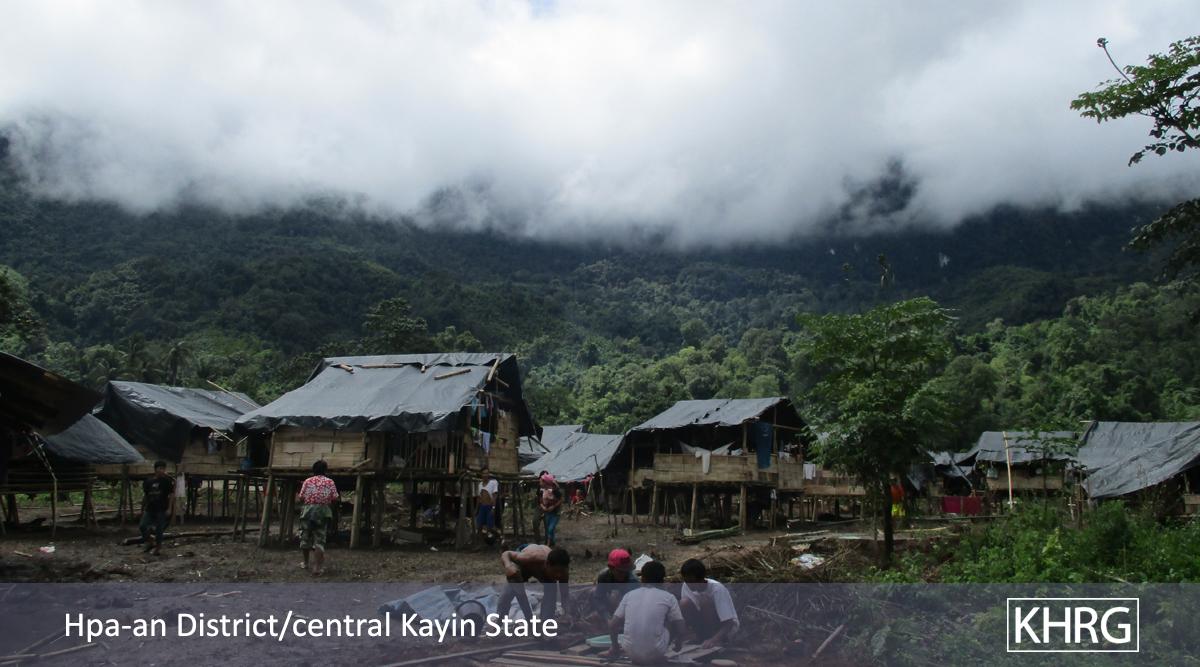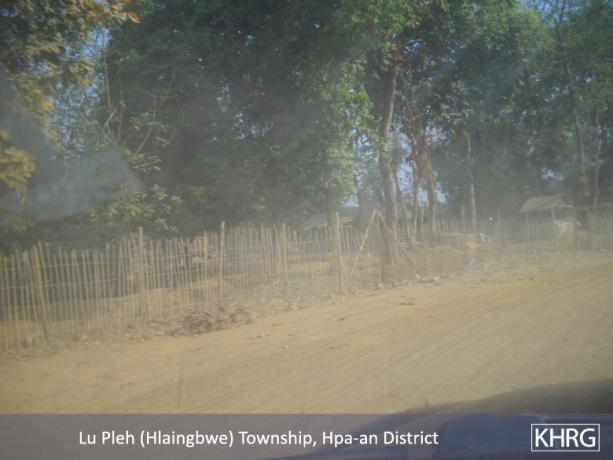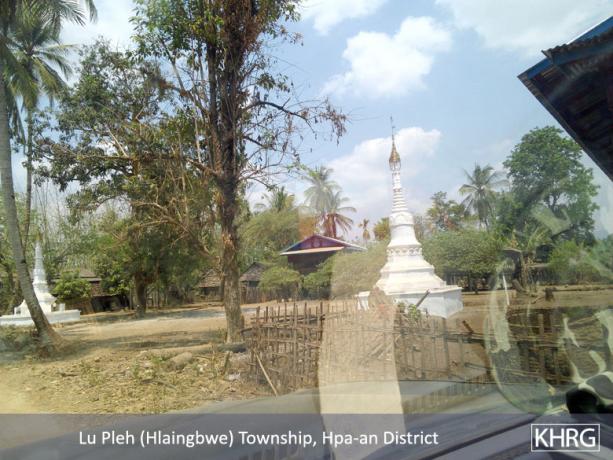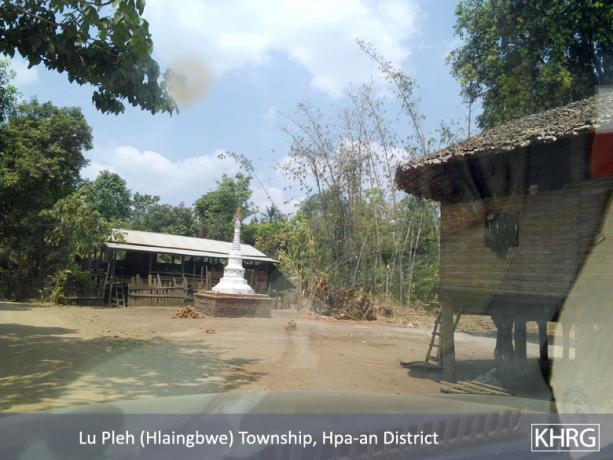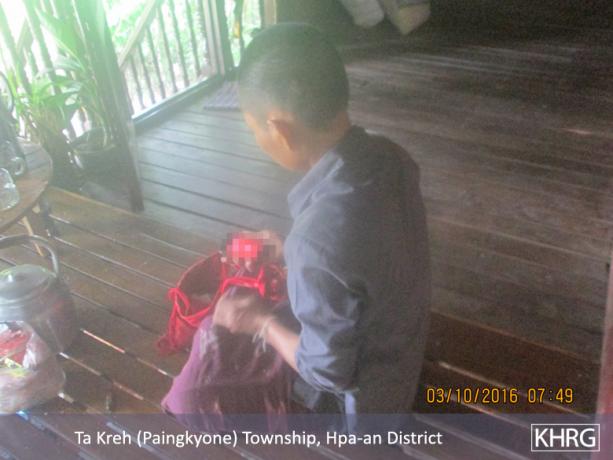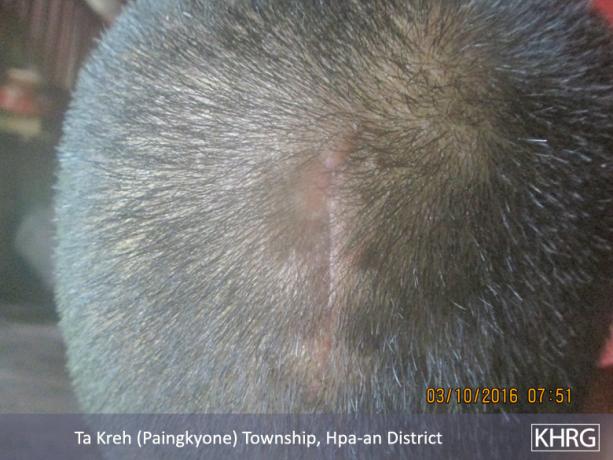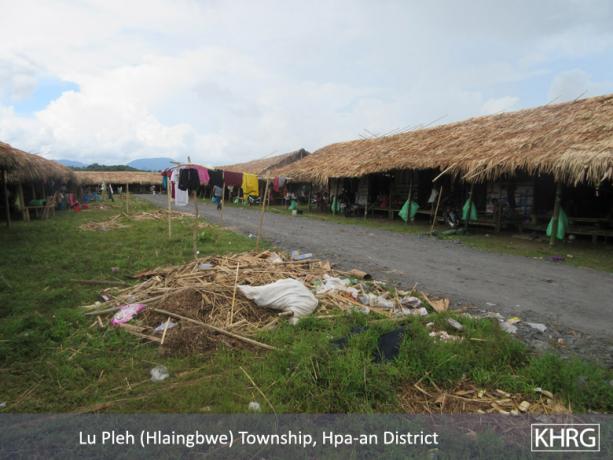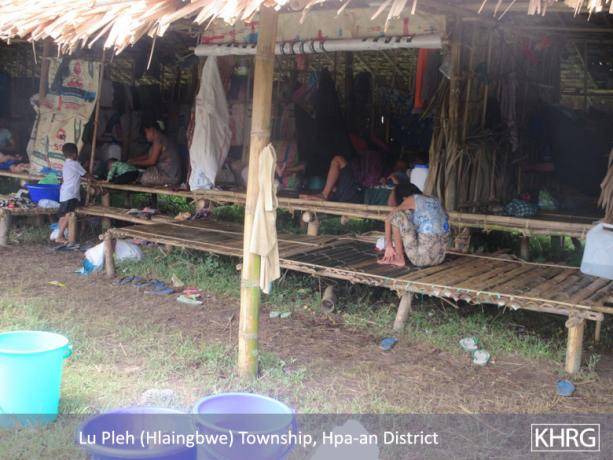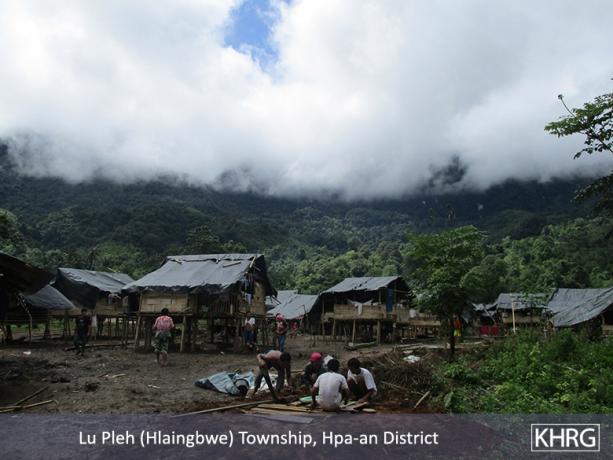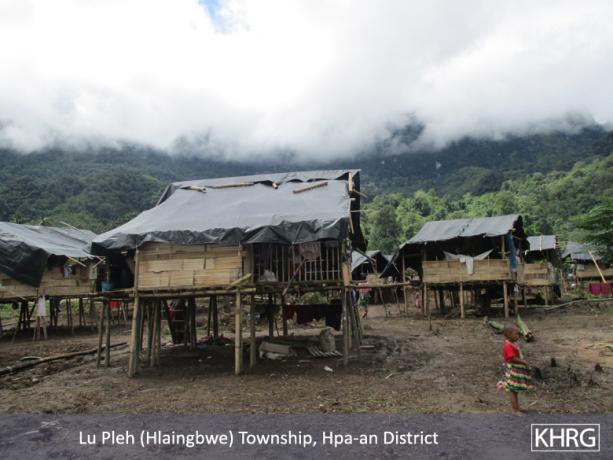This field report includes information submitted by KHRG researchers detailing events occurring in Hpa-an District between January 2016 and December 2016. It describes different human rights violations and other issues important to the local community including, arbitrary taxation by Karen National Union (KNU), KNU/KNLA-Peace Council (KNU/KNLA-PC) and Border Guard Force (BGF), road construction and its impacts, logging, forced recruitment, explicit killings, landmine incidents, and the large-scale displacement of civilians due to the Tatmadaw and BGF offensive against the Democratic Karen Buddhist Army (DKBA splinter group) in early September 2016.
-
Between April and September 2016, three separate killing incidents happened where five people in total were killed based on witchcraft suspicions in Paingkyon Township, Hpa-an District.
-
In 2016, Myanmar government officials from the land department in Paingkyon Township surveyed lands for villagers in some village tracts in Paingkyon Township with the purpose of providing land grants to villagers in the area.
-
One villager was accused of burning a rubber plantation owned by a member of the BGF and was fined four million kyat (US $3,372.04) in April 2016.
-
Community members reported significant challenges caused by overlapping and arbitrary taxation from the Karen National Union (KNU), Karen National Union/Karen National Liberation Army-Peace Council (KNU/KNLA-PC) and BGF, who collected taxes from the local villagers as regular income for their organisations.
-
This field report also discusses the concerns of villagers over the construction of Buddhist stupas on and near church land and villagers’ housing compounds by Monk U Thuzana.
-
Community members reported improvements in healthcare and education services provided by both Myanmar government and KNU in many village areas throughout 2016.
Hpa-an District is a mixed-control area between both the Karen National Union (KNU) and Burma/Myanmar government, and consequently, the two administrations define the townships in Hpa-an differently. Hpa-an Town is also the capital of Kayin/Karen State under Myanmar government recognition and is located in the centre of Karen State as recognised by the KNU. Hpa-an District has five KNU defined townships: Lu Pleh (Hlaingbwe), Ta Kreh (Paingkyon), T’Nay Hsah (Nabu), Htilon and Doo Yaw (Don Yin) townships. This Field Report covers human rights abuses and other issues which occurred in three of the five townships between January 2016 and December 2016. The Field Report summarises and analyses in detail villagers’ testimonies and perspectives regarding human rights issues in Hpa-an District.
In 2016, based on the information that KHRG received during this reporting period, human rights violations had increased in Hpa-an District compared to the previous year. There were ongoing human rights concerns such as arbitrary taxations, the negative impacts of road construction, logging, forced recruitment by armed groups, explicit killings, landmine incidents, and large scale displacement of civilians due to fighting. This Field Report also discusses the concerns of villagers over the construction of Buddhist stupas by Monk U Thuzana,[1] and their perspectives on healthcare and education in the village areas.
The incidents and information that are analysed in this field report occurred within the annual reporting period between January 2016 and December 2016, in Hlaingbwe, Paingkyon and Nabu townships, Hpa-an District.
Military activities
In 2016, the armed groups that operated in Hpa-an District were Tatmadaw, Border Guard Force (BGF),[2] Karen National Liberation Army (KNLA), Karen National Union/Karen National Liberation Army - Peace Council (KNU/KNLA-PC), and the Democratic Karen Buddhist Army (DKBA splinter).[3]
The transition of Tatmadaw and BGF battalions
On February 25th 2016, Tatmadaw soldiers from two Light Infantry Battalions (LIBs) and one Infantry Battalion (IB) withdrew from their army camps and were replaced with BGF battalions. Tatmadaw soldiers from battalions under control of Military Operation Command (MOC) #12, which are Light Infantry Battalion (LIB) #338, #339 and Infantry Battalion (IB) #28 withdrew and were replaced with BGF soldiers from Battalions #1015[4] and Battalion #1016. The LIBs and IB were based in army camps along the Hlaingbwe main road towards Meh Th’Waw, in camps T’Bluh Klah, K’Ma Hkoh, Toh Doh, Poo Loo Plaw and Hpaw Pah Hta. BGF battalions #1015 and #1016 are under command of BGF’s Cantonment Area #4 Command in Hlaingbwe Township, Hpa-an District. The Tatmadaw soldiers who withdrew from the camps returned to their military headquarters in Hlaingbwe Town. The BGF placed ten to 15 soldiers in each camp while Tatmadaw placed one officer of the rank Lance Corporal or Corporal in each of these army base camps to monitor the camps.[5]
Arbitrary taxation and demands
KHRG has received reports about villagers’ concerns regarding KNU, KNU/KNLA-PC, BGF and Tatmadaw collecting taxes consistently over the years, from Hpa-an District.
According to some villagers, KNU, KNU/KNLA-KPC, BGF and Tatmadaw collect taxes in all five townships in their control areas throughout Hpa-an District. Some of the areas are controlled by individual armed actors while some areas are mixed control between the armed groups.
In 2016, the type of items that KNU taxed for include; betel nut,[6] charcoal mounds, cars, plain farms, fish traps, conical fish nets, muskets, sawmills, chain saws, rice milling machines, logs and stone mining. In addition to financial taxes, they also ask for paddy rice and money for food for the KNLA soldiers. When the KNU collect taxes they provide an official tax receipt for every kind of tax. They collect them at the beginning or end of the year and they collect the same amount of tax in each area. This is the main source of income for the local district KNU officials and they do this tax collection each year. Villagers have expressed that if they know in advance the amount and the payment schedule, and what the tax will be used for, they accept taxation. However, when the taxation demands are unexpected, without receipt, for unclear reasons, they can be considered arbitrary and add a specific financial burden to villagers.
The KNU/KNLA-PC’s leaders and soldiers who operate in Hpa-an District introduce themselves to villagers as the Peace Council (PC) group and inform villagers that they do not collect taxes from villagers. However, villagers reported that some local KNU/KNLA-PC’s leaders and soldiers disobey these promises because they do collect taxes from the villagers. Villagers express that the Peace Council group collect tax without any proper timeline so is unsuitable for local villagers. This creates difficult situations for the villagers because sometimes when they collect tax, villagers do not have money to pay them therefore villagers are placed in a situation of debt by borrowing from other people to be able to pay unexpected, arbitrary taxes. In addition, the Peace Council group do not set a specified amount for items to be taxed so they tax unpredictably each year. Furthermore, they do not provide an official receipt for the items that they tax. Mostly, villagers reported that the Peace Council group only tax within their area of administrative control.
In 2016, the items that the KNU/KNLA-PC collected taxes for include: fish traps, cars, logs, sawmills, charcoal mounds and chainsaws. Moreover, they also set up road and river checkpoints and collected tax from cow traders, villagers who trade logs, and motor boats who have to pass through.
In 2016, two BGF battalions operated in Paingkyon Township: Battalion #1015 and Battalion #1016. The BGF are divided into two different functions which are military and administration. The military takes responsibility for all security issues while the administration takes responsibility for the judiciary and for tax collection. As part of tax collection, BGF’s administration set up checkpoints and now collects taxes from the villagers who carry charcoal with tractors. They tax between 500 kyat (US $0.41)[7] and 5,000 kyat (US $2.46) per tractor, from the driver, each time they pass the checkpoints in Paingkyon Township. They also collect taxes from cow and buffalo traders when they pass the checkpoints. They demand 5,000 kyat (US $4.11) per cow or buffalo. Elephant mahouts are also taxed if they pass by the checkpoint with an elephant. The different battalions of the BGF also reportedly collect the same types of tax in other townships in Hpa-an District. The items that BGF tax for include: cars, sawmills, chainsaws, motor boats, fish traps, tractors and charcoal mounds every year. Furthermore, when BGF celebrates its annual BGF Day (August 20th) which is the anniversary of the formation of the BGF, they collect additional taxes from villagers in the areas to support their celebration.
Regarding the BGF’s responsibility for the judiciary, when a social conflict happens they, at times, take action on it. However, villagers report that when the BGF administration takes action, people who are accused of committing abuses have to pay money for the judicial process. Villagers report that mostly, the case is resolved in favour of powerful people who commit abuses because they bribe the BGF officials. So, victims do not have justice due to this corruption.
Likewise, the BGF in Paingkyon Township were also given permission by the Myanmar government to carry out community development projects such road construction in village areas. According to the villagers, the BGF leaders who implement the project did not consult or hold a meeting with villagers prior to the project implementation. They also sell plots of land which have been confiscated from the villagers.
BGF soldier recruitment
In between November 2015 and February 2016, with the permission from the Tatmadaw, the BGF officers in Paingkyon and Hlaingbwe townships conducted two military trainings from two different locations for their newly recruited soldiers in Paingkyon Township. The first training was conducted in November 2015 in Ler Gher, Hpah Ka and T’Moh village tracts which contained 70 newly recruited soldiers. The second training took place in February 2016 in Meh Proo village tract and it included 100 newly recruited soldiers.
According to local sources, the BGF forcibly recruited ten villagers per village to be soldiers in both Paingkyon and Hlaingbwe townships. They also demanded five baskets or rice and 500,000 kyat (US $410.62) per village. Both trainings took one month to complete and after the training, the newly trained and recruited soldiers were asked to return to their villages. Later on, the BGF officers went to take photos of the newly recruited soldiers who completed the training to make them official soldiers of BGF as recognised by the Tatmadaw.
BGF fined a villager for alleged arson and plantation damage
On April 13th 2016, a B--- villager named Saw A---, who is 65 years old, was accused by BGF Company Commander Dee Ter Ler of setting fire to the BGF company commander’s rubber plantation and fined four million kyat (US $3,372.04). The incident happened in C--- village, Noh Hkwee village tract, Paingkyon Township, Hpa-an District.[8]
According to Saw A---, prior to the incident, around 10 AM in the morning, he and one of his grandchildren had gone to find vegetables and passed through Company Commander Dee Ter Ler’s rubber plantation, returning home from finding vegetables at noon. According to the local source, the rubber plantation was set on fire at around 1 PM, at which time Saw A--- was not in the area.
According to the local villagers, previously, the Company Commander demanded five million kyat (US $4,215.05)from Saw A--- although the worth of the plantation was said to be only four million kyat (US $3,372.04). Villagers attempted to appeal to the Company Commander to reduce the fine demanded of Saw A---, and he finally reduced it to four million kyat (US $3,372.04). Saw A--- was ordered to pay the fine within a single month. However, Saw A--- is not rich so he faced difficulties to pay the fine and by May 2016 had still not found a way to pay the fine.
Road construction and logging
In 2016, villagers in Paingkyon Township had encountered some common difficulties such as logging and the negative impacts of road construction that impact them in their daily livelihood tasks. Of concern, the groups that take charge of these projects are members of armed groups, notably KNU/KNLA-PC and the Border Guard Force (BGF). The involvement of armed actors in development projects leads villagers to face challenges when they wish to report their concerns about the issues as they fear negative retaliation if they complain about the actions of these armed groups.[9]
In early March 2016, BGF Cantonment Area #2’s Commander Saw Kya Aye, the KNU/KNLA-PC Operations Commander Maung Shway Kyaw, and members of the Steel Stone Company met at the bottom of K’Lee Ma Mountain for the planning of road construction. This mountain is situated close to KNU/KNLA-PC’s headquarters in Naw T’Ya Way Thaw, T’Nay Hsah (Nabu) Township.
On agreement of the plan, the Steel Stone Company started the road construction on April 1st and completed the construction on May 10th 2016. The constructed road passes through Paingkyon Township at the bottom-west side of Taw Naw Mountain range and through Pee T’Hka, Noh Hkwee, Kyeh Too Ra, Pray Htaw Roh, Meh Pa and Ta Moh village tracts. They brought two bulldozers, six backhoes and some front loaders when they were constructing the road. The road has been completely built. According to the local villagers, the road construction damaged residents’ land and plantations.
In addition to road construction, the Steel Stone Company road constructors also logged trees on the top of T’Moh Hkee Mountain, T’Moh Hkee village tract. They logged the mature trees and transported them down to Shwe Ko Ko village.
Regarding the logging and road construction, those responsible went to get permission from the KNU Hpa-an District administrators before the implementation. However, local villagers commented that they were not being informed or consulted about the road construction.
Burma/Myanmar government activity
In 2016, Burma/Myanmar government officials from the land department in Paingkyon Township surveyed lands for villagers of some village tracts in Paingkyon Township for the purpose of providing land grants. However, not all places were surveyed within the village tracts. Furthermore, based on a Situation Update written by a KHRG community member,
“The Burma/Myanmar government said they would provide land grants to the villagers, but they only provided them to some villagers and some [other] villagers did not receive them. There are more people who did not receive land grants than people who did receive land grants.”[10]
In addition to this, the Burma/Myanmar government officials also collect between 300,000 kyat (US $246.37) to 500,000 kyat (US $410.62) per village tract per year as unspecified tax. Some of this unspecified tax was donated to the monastery, whilst villagers were not informed where the remaining funds raised in this way were used.
Construction of telecommunication towers
In early 2016, the Myanmar government officials in Paingkyon Township proposed to set up telecommunication posts throughout Paingkyon Township. Therefore, in March 2016, Telenor Company staff from Yangon City went to Paingkyon Township with the relevant Myanmar government travel document (for permission) and met with Paingkyon Township’s KNU leaders to discuss about the construction of telecommunication towers. Eventually, the Paingkyon Township KNU’s leaders permitted them to carry out the construction along with a written KNU permission letter. Local villagers reported that they are in support of telecommunication towers being set up in the area. According to one KHRG community member, KNU leaders allowed the Telenor Company to set up only four towers throughout Paingkyon Township and the company had to commit to a strict construction schedule where they must construct one tower at a time. As of June 2016 the company constructed the first tower in Kyeh Too Ray village, Kyeh Too Ray village tract. A KHRG community member reported that the Telenor Company bought half an acre of villagers’ land at a good price in order for them to access land to build each telecommunication tower post.
Restitution of confiscated lands
In 2016, the Burma/Myanmar government official of Paingkyon Township and the Paingkyon Township KNU’s leaders cooperated together and returned some confiscated lands to their former owners. According to one KHRG community member, the Paingkyon Township KNU’s leaders held a consultation meeting with the Burma/Myanmar government officials for the restitution of confiscated land to local villagers. The land had been previously been confiscated by the Burma/Myanmar government and Tatmadaw. Many villagers in Paingkyon Township got back their lands so they are able again to support themselves in earning their daily livelihoods through farming.[11]
Furthermore, Paingkyon Township KNU officials from the land department surveyed lands for the villagers and provided land titles. Villagers paid between 2,000 kyat to 5,000 kyat (US $1.48-$3.70) for the surveying, depending on the width of the land. This fee also includes the fees for measuring land, receiving the land title documentation and a land tax. Officials from the KNU land department also surveyed monastery, church and cemetery compounds, and reserved an area of forest as ‘community forest’ which cannot be logged or built on. The steps taken by the KNU land department officials were said to make villagers feel more secure and better protected from the threat of land confiscation.
Stupa building leads to religious tension
In April 2016, KHRG received information about Sayadaw U Thuzana, also known as Monk Myaing Gyi Ngu, building several white Buddhist stupas in A--- village, Kwee Lay village tract, Hlaingbwe Township. Some stupas were built on villagers’ land whilst one was built on an Anglican Church compound, without explicit consent. Sayadaw U Thuzana and his followers built a stupa in the western part of the church compound. He built each of the stupas eight cubits[12] high and five cubits wide. The distance between each of the stupas was 20 arm spans.[13] The stupas were built in front of people’s houses and some at the end of the village bridge.
Related to the construction of stupas no one in the community dares to talk about this issue or raise their concerns even though the stupas are built on their land or church compound because Sayadaw U Thuzana is influential in the area. The people who helped Sayadaw U Thuzana to build the stupas are villagers from C---, D---, E--- and F--- villages and also some of the Buddhist residents of A--- village. One KHRG community member reported that some people who were involved in building the stupas strongly believe in the monk as a religious leader. However, other people who are not Buddhist or Sayadaw U Thuzana followers said that the stupas are not real stupas; they are only conflict stupas (built to provoke conflict between Buddhist and none Buddhist community).[14]
Gambling
In February 2016, villagers reported that the BGF and KNU/KNLA-PC leaders celebrated Ar Wer day[15] in Nabu, Hlaingbwe, Paingkyon and Don Yin townships in Hpa-an District. The armed groups engaged in gambling activities during the celebration.[16]
According to the local villagers, each dry season the BGF and KPC leaders in Hpa-an District celebrate Ar Wer day for the purpose of raising money for their groups. For the implementation of Ar Wer day, the BGF and KPC leaders hired Karen traditional done dancers and traditional Myanmar dramatists for the performance while the leaders engaged in and encouraged gambling among the attendants. There were many types of gambling that were played during the Ar Wer day celebration. The groups that were hired to perform at the celebration were paid between 700,000 kyat (US $574.87)[17] and 1,000,000 kyat (US $821.24) for three nights performance by the BGF and KPC leaders. This gambling is organised for more than one month in the summer across different locations. The BGF and KPC leaders collected gambling taxes every night from the gambling organisers and they used some of this money to pay the performance groups.
Specifically, in Paingkyon Township, the BGF leaders who organised the gambling were from Battalion #1015 and #1016, and the KNU/KNLA-PC’s Operations Command #3 leaders and soldiers from Htaw Meh Pah’s Battalion. The locations where the BGF and KNU/KNLA-PC conducted Ar Wer day were on villagers’ farms and these fields were polluted with rubbish left behind after the celebrations. According to the local villagers, the farm owners were not pleased with the actions of the BGF and KNU/KNLA-PC, therefore they reported the issue to village leaders, monks, KNU/KNLA-PC soldiers and BGF soldiers. After their concern was widely known in the area, the Ar Wer day celebration was arranged to be carried out on unfarmed lands where the villagers do not grow paddy, to avoid this pollution problem again. However, villagers also raised their concerns that this type of event can create social problems, as it encourages gambling additions. Many villagers gambled away their gold, money and properties.
Witchcraft killing incidents
In 2016, KHRG received three separated killing cases related to separate witchcraft accusations that occurred between April and September 2016 in Paingkyon Township, Hpa-an District.[18]
Incident #1
The first incident happened on April 9th 2016, at night time, when a male B--- village villager named Saw C--- was dragged by a group of villagers who beat him to death with wooden sticks. The case happened in B--- village, Taung Sone village tract, Paingkyon Township, Hpa-an District.[19]
Saw C--- was said to be suspected of practicing witchcraft by B--- villagers. According to Saw C---’s wife Naw A---, her husband was suspected of burying cursed items including red seeds, charcoal from cremations, an ogre (spirit) doll and stones possessed with evil spirits under other villagers’ houses. When social conflict occurred in the village, villagers suspected that witchcraft was to blame, blaming Saw C---. Villagers told Naw A--- that when her husband had been alive he had boasted to other villagers that he could not be arrested or killed with a knife or gun because of his witchcraft powers. However, Naw A--- explained that she had been married to her husband for 19 years and she was not aware of such issues and no villagers had raised their concerns directly to her prior to her husband’s murder. Naw A--- stated that,
“I had never heard about this [accusations that my husband made their family argue with each other] before. I only heard it after my husband was killed. They [gossipers] said they did not dare to talk to me about it frankly when my husband [was] alive. I replied to them, “Why did you not say this to his wife [me] when he was still alive, and you could still come and tell me? If you told me, I would have told my husband and taught him moral values and what is right and wrong.” They said, “We did not dare to talk about it because we were afraid that this information [witchcraft] would spread [to the authorities].” However, they dared to do it [kill my husband] in secret. They said they did it openly, and everyone knew it [but I did not know who killed my husband].”
Finally, the killing case of Saw C--- was brought before the KNU at the Paingkyon Township level and the KNU’s township authorities held a meeting with the victim’s wife Naw A---, the victim’s relatives and B--- villagers in March 2017. In the meeting, villagers admitted that they were all included in making the decision to kill Saw C---. Eventually, all villagers agreed that they would provide financial support to pay for the funeral, in addition to helping build a house for Naw A--- and her children, and supporting two of Naw A---’s younger sons, the youngest being five, in education until they reach 18 years old. As much of the village was involved in the decision to kill Saw C---, KNU was unable to take direct punitive action against all the perpetrators. However, during a meeting to discuss the killing, Paingkyon Township’s KNU administrator asked all villagers present to sign an agreement stating that from now on, villagers must not commit any crime arbitrarily related to witchcraft. Following the signing, the agreement is said to be kept at the township office. The victims’ family members and relatives were said to have agreed with the decision that the KNU official had made for them.
Incident #2
The second separate incident occurred in August 2016, when a husband and wife of G--- village were shot and killed in two separated locations on the same night at 9 PM, in G--- village, T’Moh Kloh village tract, Paingkyon Township, Hpa-an District.[20]
According to local sources, the couple was suspected of practicing witchcraft and it is believed they were killed by Border Guard Force (BGF) soldiers under General Hpah Nwee, also known as Hpuh (Grandfather) Hpah Nwee. One year prior to the incident, the couple and their family members had been accused of practising witchcraft and underwent a ceremony where they drank promissory water as an oath to no longer practice witchcraft. This ceremony was performed at BGF General Hpah Nwee’s place, where the couple were told by General Hpah Nwee not to practice witchcraft anymore. The couple was killed almost a year after they drank the promissory water.
In August 2016, the husband was shot and killed at his farm hut, whilst at the same time his wife was taken from her house and shot and killed in front of the village primary school. Both husband and wife were killed by machine gun. The people who killed the couple asked villagers to bury the dead bodies. The perpetrators also told the victims’ surviving family members,’ relatives and other villagers not to report about the killing case, threatening to kill all family members if they report the case and if news of the killings were to spread.
Following the threats, villagers felt afraid and were unwilling to report the killing case to authorities. The female victim’s mother stated that,
“I have been in fear since people killed my daughter and my son-in-law. [...] We were really afraid because people told us that they would kill all of us [relatives] if [information about] this case spreads and if other people know about it, or if they know for sure that people reported about this incident.”
Furthermore, as the woman was shot and killed directly outside the village school, at the time of reporting, teachers and students did not feel safe to teach and study at school anymore. Instead, they were teaching from a villager’s house.
Adding to an environment of insecurity and lack of rule of law, there has been no action from authorities for this case as the family report that they remain fearful to report it to authorities.
Incident #3
A further incident took place in Hpa-an District, September 2016 at 3 AM in the morning, when three family members were attacked by a group of armed robbers, which led to two of the family members being killed and one surviving with serious head wounds. According to the surviving family member, the elderly mother who had been killed had locally been accused of practicing witchcraft. The villagers who were attacked were Naw L---, 43 years old who sustained a serious head injury, Naw L---’s mother Daw P---, 87 years old and her brother Maung W---, 48 years old, both of whom were shot and killed during the attack. The raiders also robbed 3,500,000 kyat (US$2567.81) and precious properties including jewellery that belonged to Naw L---’s family. The case took place in R--- village, K’Kyoh village tract, Paingkyon Township, Hpa-an District.[21]
According to the surviving victim Naw L---,
“People said my mother and my brother were practicing witchcraft. They said my mother had a stone which was possessed by a spirit, and that my brother went to the ground floor of other people’s houses [to practice witchcraft]. People who said my mother had a stone which was possessed by a spirit called us to my cousin T---’s house and questioned me. I replied to them we did not have it [the possessed stone], and if we had to drink promissory water we would drink it in the village, but they did not do it [make us drink it]. Three traditional healers said it was my mother alone who did it [brought evil spirits] to all of the villagers’ children who got such illness and high temperatures that their children were delirious.”
The three family members had met with many shamans in order to discover and heal the evil spirits which they were accused of having in them. They drank promissory water two times in front of village leaders and villagers in attempts to quell village suspicions.
Eventually, according to Naw L---, the perpetrators who robbed her family and murdered her mother and brother were arrested by the Burma/Myanmar police and detained in Taung Ka Lay jail of Hlaingbwe Township, Hpa-an District. The people who were arrested and detained by the Burma/Myanmar police are four male members of the Karen Peace Council (also known as the KNLA/KNU-PC) from Battalion #773. According to local sources, as of March 2017, Paingkyon Township KNU leaders had met with village tract leaders and Naw L--- in order to address the complaint that village tract leaders had been involved in the decision to kill the family members. During the meeting, village tract leaders denied the accusation that they had been involved, and reported that they had not been aware of the plan to commit this crime. Additionally, Naw L--- reported that the Burma/Myanmar police had found all the property stolen from her and, despite promising to return it to Naw L---, no stolen property had been returned.
Fighting between DKBA (Buddhist-splinter) and joint forces of Tatmadaw and BGF results in displacement and movement restrictions for local villagers
In September 2016, fighting happened in Meh Th’Waw area, Hlaingbwe Township, Hpa-an District which led to thousands of villagers becoming displaced.[22]
During September-October 2016, fighting occurred between the joint forces of Tatmadaw and BGF, and DKBA (Buddhist splinter) in Meh Th’Waw area. Thousands of villagers in Meh Th’Waw area, Hlaingbwe Township, Hpa-an District became displaced after the BGF and Tatmadaw military targeted villages with mortar shells and the opposing side, DKBA (Buddhist splinter), forced villagers to work as porters. Whilst the fighting had subsided as of October 2016, both armed groups remain in operation in the area and village land is now contaminated with new landmines planted by the DKBA (Buddhist splinter). For these reasons, thousands of villagers from Meh Th’Waw area do not feel safe to return and therefore remain displaced in IDP camps.
With regard to the details of the fighting, on September 9th 2016, the fighting broke out between the DKBA (Buddhist splinter) and joint forces of BGF soldiers from Cantonment Area #4 and Tatmadaw soldiers from Military Operations Command (MOC) #12 in Meh Th’Waw area. During the fighting more than six thousand villagers were encouraged to displace from their villages by senior monk, Sayadaw U Thuzana, who provided trucks to move villagers to Myaing Gyi Ngu (Kaw Taw) Town. Other villagers chose to flee and seek safety in nearby villages and across the Moei River to refugee camps in Thailand. Villagers who were displaced to Myaing Gyi Ngu Town and other nearby villages were provided with shelter, clothing, food, health care and education services by local groups and Myanmar-based organisations. Regardless of this support, the displaced villagers have struggled considerably due to the impact of leaving their belongings, livestock, homes and land behind, such as Saw A--- and Saw B--- from E--- and F--- village respectively:
“Are there any livestock left in your village?
Saw A--- and Saw B---: Yes, the goats, chickens, and buffalo were left behind in the village.
So all of your belongings were left in your village?
Yes, some of them [our livestock] stepped on the landmines.
[…]
How many days did it take you to flee from your village to D--- village?
It took me one day to come here, but it was very hard for us to travel with children in the rainy season. We did not bring any rain clothes with us. My kids were crying when we were fleeing.
Did you flee in the night time?
Yes, we fled in the night time.
Did you flee there by yourself?
Yes, we fled here by ourselves.
Had there been any shelling in your village?
No, we just heard gunfire around our village.
Can you tell me how the incident happened, step-by-step?
Saw B---: We faced many difficulties even before we fled. Since we have been facing many things before the fighting took place, we felt more unsafe and it made us full of worry. If we say it in another way, when we put many kilos of pork on the weighing scale there will be too much weight for the weighing scale to weigh [we had already endured so much we were at a breaking point]. When the fighting occurred we did not feel safe and we thought carefully about the situation. We did not dare to face the BGF and the DKBA. As we were villagers this incident became very difficult for us. They [DKBA splinter] did not respect us because they poured all our rice on the ground.”
In the run up to the fighting that began on September 9th 2016, villagers faced harassment and abuse by the DKBA (Buddhist splinter). Villagers were ordered by the DKBA soldiers to porter food and serve on sentry duty. In A--- village, when the fighting broke out in the nearby areas, DKBA’s soldiers ordered two to three villagers from A--- village to porter for the soldiers in shift rotation, without pay. Villagers were ordered to carry woven baskets with soldiers’ food, ammunition and landmines inside. The DKBA soldiers laid these landmines in the forest.
Naw P---[23] also reported to a KHRG community member that, before her and other villagers from A--- village fled to Myaing Gyi Ngu Town, fighting had occurred in her village because DKBA soldiers had been based there temporarily. According to Naw P---, BGF and the allied Tatmadaw soldiers entered into areas near to A--- village and they exchanged fire. Because of this fighting, artillery that had been shelled by BGF and Tatmadaw soldiers fell and exploded in A--- village but fortunately did not hit any A--- villagers. Due to this incident however, A--- villagers were afraid and wanted to flee from the village to protect themselves from further risk, but DKBA soldiers told them not to be afraid or flee. Instead, DKBA soldiers suggested that the villagers dig bomb shelters under their houses and stay in the village. Later, villagers heard that Sayadaw U Thuzana had arranged trucks to pick up villagers from fighting areas so many of them decided to use this transport option to leave for Myaing Gyi Ngu Town instead of staying in A--- village.
Landmine incidents
In the above case of recent fighting and displacement, displaced villagers’ safety and livelihoods were also threatened by landmines. IDPs (internally displaced persons) reported to KHRG that prior to the fighting, the DKBA (Buddhist splinter) had recently planted landmines in those areas. Most of these landmines are reported to be hand-made, and are planted in village areas and work places, causing severe risk for villagers who want to tend to their fields. Before the villagers fled, some of the villagers’ buffaloes had already stepped on the DKBA landmines, causing injury and potential death to livestock. Then, the fighting forced villagers to leave the rest of their livestock behind, leaving the livestock exposed to the same fate as the injured buffaloes.
Not only livestock have been injured or killed by DKBA (Buddhist splinter) landmines since September 2016. At least one village head has been killed and another injured by landmines planted in the area since the fighting in September 2016.
On September 16th 2016, A--- village head U T--- stepped on a landmine and died beside A--- village. U T--- stepped on a landmine while he went back to his village to be with his villagers who remained in the village area rather than displacing himself to be away from the fighting. As village head, he remained with villagers with a feeling of duty to help and protect them from any form of harm.
According to U T---’s wife, Naw P---, U T--- did not die immediately but villagers were fearful to carry him back to the village from where he lay injured from the landmine. This was because when he stepped on the DKBA landmine, the BGF and Tatmadaw soldiers who were based in the village opened fire at the location where the landmine had exploded. Instead of carrying him back to the village, the villagers therefore brought him back to their hiding place in the valley. Then they sent some villagers to inform the BGF and Tatmadaw soldiers about the incident and to allow them to safely bring their village head back to the village for treatment. U T--- died on the way when villagers carried him back to the village because of the injuries that he had sustained from the landmine explosion.
Additionally, according to a responsible leader of Myaing Gyi Ngu’s IDP site, on October 1st 2016, an E--- villager name Saw K---, who is over 20 years old, stepped on a landmine in E--- village area, close to A--- village, and sustained injuries.
Healthcare improvement
In Hpa-an District, villagers could access and rely on the healthcare systems from both the Burma/Myanmar government and the KNU, in addition to non-governmental organisations (NGOs) and local community based organisations (CBOs) active on healthcare issues. Due to the increase in service providers, more services were easily available for villagers.
In Hlaingbwe Township, the Back Pack Health Worker Team (BPHWT) provided healthcare and treatment in the villages from Hkler Day, Kwee Law Hploh, Daw K’Kya, Meh T’Moo and Klaw Kyaw village tracts. In other village tracts, there are village-level clinics however, if the diseases are serious, the patients are sent to hospitals in Hlaingbwe or Hpa-an Town.
Additionally, KNU had built three hospitals in Paingkyon Township in 2015, and in 2016 many healthcare providers including the Karen Department of Health and Welfare (KDHW), Shoklo Malaria Research Unit (SMRU), Emergency Obstetric Care (EmOC), local community health workers and the Maternal Child Health (MCH) team were working together in those hospitals. One of the hospitals was built between Pee T’Hka and Noh Hkwee village tracts, while one more was built in T’Moh village tract. The third hospital was built in Wa Mee Klah village tract. These hospitals are run under Paingkyon Township’s KNU administration and central KNU.
These three hospitals have OP (Out-Patient) and IP (In-Patient) departments. The health workers from the hospitals also go to the villages and collaborate with local health workers therefore, more villagers gradually have access to their healthcare services.
The improvement in access to a widened variety of healthcare services also involved the Burma/Myanmar government in 2016, who constructed clinics in Paingkyon Township. Some NGOs also tried to access the area to support healthcare on the ground. The Adventist Development and Relief Agency (ADRA), Japan Tobacco International (JTI) in addition to other NGOs entered and implemented health projects including constructing clinics, wells, toilets and installing water pipes for local villagers in Paingkyon Township, Hpa-an District. Therefore, villagers in Hpa-an Township benefitted from improved access to basic health care in 2016.[24]
However, whilst the Burma/Myanmar government set up clinics and placed some of their health workers in certain areas of Hpa-an District, some areas which are more isolated continued to lack medicine and health workers. Villagers also reported that they feel suspicious that the Burma/Myanmar government just built the clinics to claim ownership of local land. In some of these Burma/Myanmar government clinics, the medicine that is stored is out of date, according to villagers who went to take medicine from the clinics. Villagers and local leaders reported this issue to the Myanmar government and the KNU with the hope that this issue can be resolved.
Education
In Hpa-an District, prior to the 2012 preliminary ceasefire[25] between the Burma/Myanmar government and the KNU, there were only a few schools in each township of Hpa-an District, especially in KNU controlled areas. However, following the signing of the preliminary ceasefire and the Nationwide Ceasefire Agreement,[26] more schools have been constructed by both the Myanmar government and the KNU, as well as other CBOs and NGOs. Therefore, as of 2016 there has been greater availability of education facilities in Hpa-an District. Most of these schools are primary schools which teach up to Fourth Standard[27] and are mainly run by the education departments from Myanmar government and KNU. Students who finish at Burma/Myanmar government primary schools must also attend Burma/Myanmar government high schools in nearby towns to continue their studies, while students who finish from KNU primary schools must attend KNU high schools as they have been schooled under a different curriculum. Often the KNU high schools are a little bit far from some villages with KNU primary schools, especially in Paingkyon Township. Students who finish primary school in this Township have to go to study at KNU’s high schools in Meh T’Ree village and Thoo Mgeh Nee area, along the Thai-Burma border, to continue their studies.[28]
Conclusion
Throughout 2016, villagers in Hpa-an District have continued to suffer from ongoing human rights abuses due to several armed groups continuing to operate in the district and clash over the administration of territories. Heavy fighting between the joint forces of Tatmadaw, BGF against DKBA (splinter group) in Meh Th’Waw area led to massive displacement and landmine contamination in the district.
In addition, the arbitrary killings over witchcraft suspicions demonstrate the lack of rule of law and justice for villagers. Villagers are also continually facing taxation demands from several armed actors which aggravates livelihood difficulties, and gambling encouraged by armed groups risks social harmony in the district.
The concern over religious tension between Buddhist and non-Buddhist community members continue to arise due to the construction of religious stupas on church compound and villagers’ house compounds. However, some villages have benefits from improvements of healthcare and education services in 2016.
Related to development, especially road construction, companies are seen to collaborate with armed groups and some villagers’ lands have been damaged whilst communal forest land has been logged to prepare for road construction, without consultation with affected villagers. However, the restitution of confiscated land and provision of land titles to villagers are a good example of recent government actions to secure villagers’ rights however, there remains widespread land insecurity throughout the district.
Footnotes:
[1] U Thuzana is an influential ethnic Karen Buddhist monk based in Myaing Gyi Ngu who was instrumental in the formation of the DKBA in 1994; see "Inside the DKBA," KHRG, March 1996. In 1995, KHRG reported that U Thuzana had collaborated with the Tatmadaw, and met with then-Southeastern Commander Major General Maung Hla to obtain weapons and supplies for 4,000 soldiers in his monastery. As a result of the agreement, U Thuzana’s headquarters and main monastery in Myaing Gyi Ngu, in northern Hpa-an District, reportedly developed a reputation as a mystical safe haven for villagers avoiding Tatmadaw abuses. See “Karen Human Rights Group commentary,” KHRG, February 1995. More recently monk U Thuzana has been implicated in forced labour demands and of stoking religious conflict by confiscating land to build Buddhist stupas. See “Hpapun Field Report, January to December 2013,” March 2016, and “Chapter 8: Discrimination and Division in “Foundation of Fear,” KHRG, October 2017.
[2] Border Guard Force (BGF) battalions of the Tatmadaw were established in 2010, and they are composed mostly of soldiers from former non-state armed groups, such as older constellations of the DKBA, which have formalised ceasefire agreements with the Burma/Myanmar government and agreed to transform into battalions within the Tatmadaw. BGF battalions are assigned four digit battalion numbers, whereas regular Tatmadaw infantry battalions are assigned two digit battalion numbers and light infantry battalions are identified by two or three-digit battalion numbers. For more information, see “DKBA officially becomes Border Guard Force” Democratic Voice of Burma, August 2010, and “Exploitation and recruitment under the DKBA in Pa’an District,” KHRG, June 2009.
[3] For more information, see “Hpa-an Situation Update: Hlaingbwe Township, February to April 2016,” KHRG, August 2016.
[4] KHRG has received numerous reports of human rights violations by BGF Battalion #1015, including arbitrary killing of civilians, arbitrary taxation and demands, forced labour, as well as additional cases of land confiscation. For detailed information see, “Hpa-an Situation Update: Hlaingbwe and Paingkyon townships, March to May 2016,” KHRG, September 2016, and “Human rights violations by BGF Cantonment Area Commander Kya Aye in Paingkyon Township, Hpa-an District, February 2013 to July 2014,” KHRG, September 2014.
[5] For more information, see “Hpa-an Situation Update: Hlaingbwe and Paingkyon townships, March to May 2016,” KHRG, September 2016.
[6] In Burmese, ‘betel nut’ and ‘betel leaf’ are referred to as konywet and konthih, respectively, as if they are from the same plant. The Burmese names are also commonly used by Karen language speakers. Betel nut is the seed from an areca palm tree, Areca catechu; "betel leaf" is the leaf of the piper betel vine, belonging to the Piperaceae family.
[7] All conversion estimates for the kyat in this report are based on the 11th December 2017 official market rate of 1356 kyat to US $1, or otherwise taken from the original published KHRG report source.
[8] See, “Hpa-an Incident Report: Villager accused of burning BGF rubber plantation in Paingkyon Township, April 2016,” KHRG, August 2016. KHRG has received previous reports involving human rights violations by Border Guard Force (BGF) Company Commander Kyaw Hein, also known as Dee Ter Ler, including land confiscation in Paingkyon Township. See, “Hpa-an Incident Report: Land confiscation in Paingkyon Township, May 2015,” KHRG, August 2015.
[9] This information was taken from an unpublished report from Paingkyon Township received in March 2016.
[10] This information was taken from the published report, “Hpa-an Situation Update: Hlaingbwe and Paingkyon townships, March to May 2016,” September 2016.
[11] This information was taken from an unpublished KHRG report from Paingkyon Township. For further information see Karen News “NLD Hand Back 232 Acres Confiscated Farmlands – Rightful Owners Not Happy,” Karen News, June 2016.
[12] A cubit is a standard measurement for the length of bamboo poles, commonly referred to in Karen as the length from one’s fingertips to one’s elbow, about 45.7 centre metres or 18 inches.
[13] An arm span is a unit of measurement equivalent to six footsteps (kaw yaw), 6 feet, 2 yards or 1.8 meters.
[14] This information was taken from, “Hpa-an Situation Update: Hlaingbwe and Paingkyon townships, March to May 2016,” KHRG, September 2016.
[15] ‘Ar Wer day’ is a term coined by DKBA, BGF and KPC and used to describe special days, hence the expression ‘Ar Wer day.’ Ar Wer day events typically involve celebrations to mark a special occasion such as the building of a new pagoda or to honour these armed groups. Sometimes people also engage in illicit activities such as gambling and drug use on Ar Wer days. The Ar Wer Day is primarily celebrated by armed groups to serve as a main fundraising activity for them.
[16] This information was taken from, “Hpa-an Situation Update: Hlaingbwe and Paingkyon townships, March to May 2016,” KHRG, September 2016.
[17] All conversion estimates for the kyat in this report are based on the 5 September 2016 official market rate of 1,217.67 kyat to the US $1.
[18] This information was published as, “Three separate killing incidents based on witchcraft suspicion in Hpa-an District,” KHRG, July 2017.
[19] This information was taken from, “Hpa-an Interview: Naw A---, September 2016,” KHRG, September 2016.
[20] This information was published as, “Three separate killing incidents based on witchcraft suspicion in Hpa-an District,” KHRG, July 2017.
[21] This information was published as, “Three separate killing incidents based on witchcraft suspicion in Hpa-an District,” KHRG, July 2017.
[22] See, “Recent fighting between newly-reformed DKBA and joint forces of BGF and Tatmadaw soldiers led more than six thousand Karen villagers to flee in Hpa-an District, September 2016,” KHRG, December 2016, and “Hpa-an Interview: Saw A--- and Saw B---, October 2016,” KHRG, February 2017.
[23] In the previously published KHRG news bulletin, Naw P--- was censored as Naw L---.
[24] For more information see, “Hpa-an Situation Update: Hlaingbwe and Paingkyon townships, March to May 2016,” KHRG, September 2016.
[25] On January 12th 2012, a preliminary ceasefire agreement was signed between the KNU and Burma/Myanmar government in Hpa-an. Negotiations for a longer-term peace plan are still under way. For updates on the peace process, see the KNU Stakeholder webpage on the Myanmar Peace Monitor website. For KHRG's analysis of changes in human rights conditions since the ceasefire, see Truce or Transition? Trends in human rights abuse and local response since the 2012 ceasefire, KHRG, May 2014. In March 2015, the seventh round of the negotiations for a national ceasefire between the Burma/Myanmar government and various ethnic armed actors began in Yangon, see “Seventh Round of Nationwide Ceasefire Negotiations,” Karen National Union Headquarters, March 18th 2015. Following the negotiations, the KNU held a central standing committee emergency, see “KNU: Emergency Meeting Called To Discuss Nationwide Ceasefire Agreement And Ethnic Leaders’ Summit,” Karen News, April 22nd 2015.
[26] On October 15th 2015, after a negotiation process marred with controversy over the notable non-inclusion of several ethnic armed groups and on-going conflicts in ethnic regions, a Nationwide Ceasefire Agreement (NCA) was signed between the Burma/Myanmar government and eight of the fifteen ethnic armed groups originally invited to the negotiation table, including the KNU, see “Myanmar signs ceasefire with eight armed groups,” Reuters, October 15th 2015. Several years on, the NCA has not materialised into a strong peace process and remains fragile. See, “KNU Chair Highlights Weaknesses In The NCA During Anniversary Celebrations,” Karen News, October 2017 and NCA signatories urge govt to reboot peace process, DVB, October 2017.
[27] A standard refers to a school year in the education system of Burma/Myanmar. The basic education system has a 5-4-2 structure. Primary school runs from Standard 1 to Standard 5, lower secondary school is Standard 6 to Standard 9, and upper secondary school is Standard 10 to Standard 11.
[28] This information was taken from an unpublished report from Hlaingbwe Township received in April 2016.

